


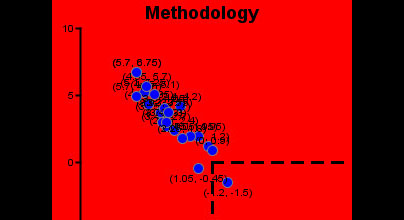

- Overview
- Methodology
- Interconnections
- Focus
- Environment
- Adaption
- Resources
Research: ©Innovation Cube
The ©Innovation Cube is a 64-question diagnostic survey. The answers indicate your individual and organizational Innovation characteristics. Because it is a self-analysis, most people immediately recognize correlations between their results and their perception of the innovation environment in which they participate.
By responding to questions asked in the areas of Personal Background, Company Background, Culture, Characteristics, Methodology and Tools a bi-directional score is provided for “Acceptance” and “Intensity” in 4 of the 6 cube quadrants. As the survey respondent unveils their responses to the survey questions an innovation mapping is created.
Preliminary Validation of the ©Innovation Cube data has shown a valid correlation between all of the quadrants with the exception of "Resources" quadrant. Explanations to this occurrence have suggested that "with or without resources, individuals who are passionate about innovation will find a way to create new, unique and novel ideas" (Deardorff, 2005).
Sample Report ![]() click to see instrument description.
click to see instrument description.
Innovation Company data plot Click to see profile ![]()
Innovation Company graphical plot Click to see profile ![]()
The ©Innovation Cube provides an individual or group composite numerical data plots and graphical representation plots of the survey results. Scores will range from -10 to +10 in each quadrant from the baseline. As positive scores are generated these indicate "strengths" to support innovation – as low or negative scores are generated these indicate "Weaknesses" to support innovation. These results are accompanied by a generic list of intervention corrections or changes required to increase the ability to support innovation.
Click Here to take the survey
Innovation Cube Methodology:
The first side of the ©Innovation Cube is 'methodology'. This feature of innovation is a reference to unique characteristics for exploring or creating cognitive ideas that converge and diverge. A methodology is a process for creating a body of practices, procedures, and rules used by those who work in an innovation discipline or engage in innovation inquiry.
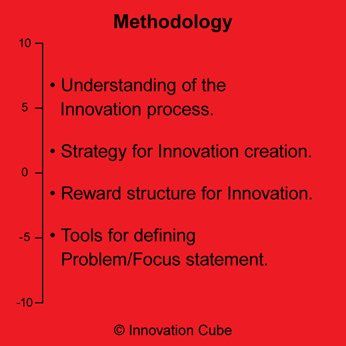
Creative problem solving or innovation “requires both divergent and convergent thinking” (Van Gundy, 1995, p. 19). During idea generation, the process of creating as many ideas as possible is a divergent thinking process. Idea evaluation on the other hand is convergent because you are trying to narrow or select the best ideas. If you attempt to accomplish both tasks at the same time, “you won’t do either one well, effective problem solvers have learned to separate these two activities” (Van Gundy, 1995, pp. 19-20).
Average problem solvers create a limited group of overanalyzed ideas because they follow a sequential process of “generate-evaluate-generate-evaluate, they rarely move on to think about another idea until they have analyzed the previous idea in all possible ways” (Van Gundy, 1995, pp. 19-20). The key is a balanced process of both methods that allows you to “generate a bunch of ideas and zoom in on one, from there you generate more ideas at a more specific level, and then zoom back in” (Shapiro, 2002, p. 77). The use of this process produces many ideas that are temporarily discarded but that can be used later, recombined, or re-assembled as the focused direction changes; but it is still a mystery how the “ability to produce many ideas is related to the ability to produce a few superb ones” (Sternberg, 1999, p. 95). Three techniques have been identified that can assist creativity as a salient goal: Lateral Thinking (de Bono, 1970), Brainstorming (Osborn, 1963), and Synetics (Gordon, 1961), but “most frequently noted are divergent thinking and associational thinking skills (Barrow & Harrington, 1981).
Divergence
The concept of divergent thinking, “or at least the possibility of complex ideation, was formulated by W. James (1880) who understood the rarity of ideational complexity” (Sternberg, 1999, p. 26). Divergent thinking refers to the ability to create a wide range of ideas, which focuses on identifying useful interconnections between independent elements. The natural tendency for individuals is to “converge onto a smaller picture when they should be diverging into a bigger one” (Shapiro, 2002, p. 79).
Guilford (1967) refers to his defined creative factors as contributing to idea creation, but the “divergent factors are counted upon primarily for this purpose” (Stein, 1974, p. 79). This idea creation depends on the divergent-productive thinking method that is responsible for the:
Ability to effect transformations of information, with the abilities of fluency, flexibility, elaboration, and redefinition playing significant roles, with creative thinking put in its larger context of problem solving, we see that any or all kinds of abilities represented in the structure of intellect can play their useful roles, directly or indirectly. (Guilford, 1967, p. 11)
Guilford considers these divergent production factors and refers to them as “divergent symbolic units,” which are comprised of “thinking up and writing out words containing a specific letter” (Stein, 1974, p. 95). That specific letter leads to word fluency and divergent production factors.
This creativity process requires breaking apart the familiar pre-established ways of seeing, doing, and thinking. Divergent thinking helps produce ideas that are considered novel, “novelty for its own sake may actually be important in early stages of creativity, when you want lots of options - even wild ones” (Leonard & Swap, 1999, pp. 6-7). The figure below illustrates the divergence process where multiple directions are established in the process.
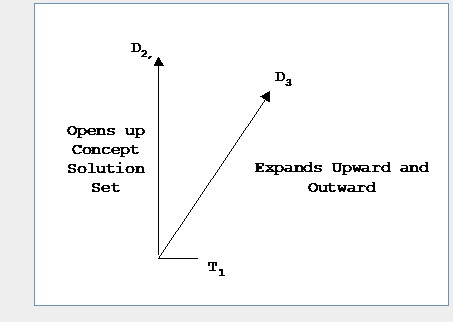
Focused Divergent Model
The relationship between novel ideas and divergent thinking has been questioned (Weisberg, 1986). Weisburg has argued that “many innovations do not represent radically different ideas or approaches to problems, but rather are better characterized as incremental advancements over existing solutions” (West & Farr, 1990, p. 212). Divergent thinking is concerned with fluicy and flexibility of thinking and the flow of creative thought with a readiness to change direction or modify information (Guilford, 1967).
There are many supporters of divergent or lateral thinking as a facilitation to an outcome (Adams, 1979). This approach has been suggested as a departure from convergent thinking in favor of a more divergent approach, but there is remarkably little evidence concerning divergent thinking in highly creative people (Barrow & Harrington, 1981). Thought processes which “expand possibilities are known as divergent, thought processes which narrow the scope are known as convergent” (Clegg & Birch, 2000, p. 25).
Convergence
It is important to recognize that “by focusing almost exclusively in cognitive processes related to problem interpretation and divergent thinking” there is a failure to represent “important roles that motivation, emotion and influence of social dynamics play in creative action taking” (Ford & Gioia, 1995, p. 350). The idea generation process must include the process of “convergent thinking, some idea that one or more of the novel ideas is worth pursuing” (Leonard & Swap, 1999, p. 7).
This description of idea generation has been hypothesized as a distinction between the divergent and convergent process.
“Convergent thinking takes existing input information and derives an answer based on that information” (West & Farr, 1990, p. 212).
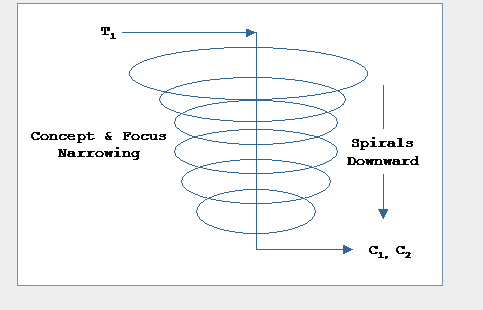
Convergent Model
“Convergent behavior also channels subsequent divergent behavior during the innovation journey,” which clarifies the cyclic nature of the systemic process (Dooley & Van de Ven, 1999, p. 26). “A general divergent attitude of thinking is not sufficient for effective creativity,” a convergence must be explored to complete the process (de Bono, 1992, p. 159). The process of successful innovation and creativity goes through a recurring and repeatable cycle, which contains modules of convergence and divergence. This is not a duplication of a “teleological model” of planned change but more of an adaptation of it broken into smaller pieces and reconstructed with the candidate’s Divergence/Convergence model (Van de Ven & Poole, 1995). When discussing the terms 'divergence' and 'convergence' in association with innovation, the following lexicon descriptions are accurate:
- Converge. To tend to meet at a point; to tend to a common result, end, and conclusion.
- Diverge. To move, lie, or extend in different directions from a common starting point; branch off; to turn aside or deviate, as from a path, practice, or plan.
The assumption made by organizations is that there is a prescribed formula for juggling these two methodologies. Barrow and Harrington (1981) have raised the question of whether convergent and divergent thinking is separable or whether they “go hand-in-hand in any problem-solving situation” (West & Farr, 1990, p. 212). The figure below describes the typical situation in organizations where there is either pre-mature convergence or divergence.
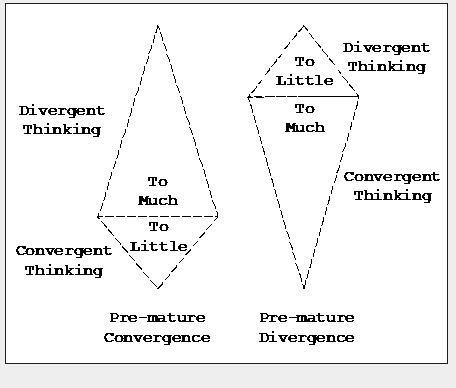
Pre-Mature Convergence/Divergence Model
This pre-mature situation causes:
1) Pre-mature Convergence: much time given to divergent thinking – forced convergence at the end with little time for discussion of implementation.
2) Pre-Mature Divergence: little time given to divergent thinking – rapid convergence and time spent on implementation. (Leonard Swap, 1999, p. 56)
What is required is balance between the two options of converging and diverging which could be described as a “balance between exploration and speed, between opening up options and closing them down as seen in the figure below.
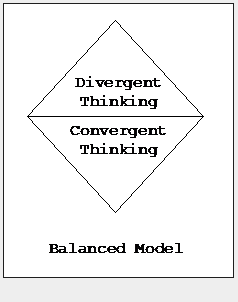
Balanced Convergence/Divergence Model
This thought pattern is a natural path for the brain to take when unstructured thinking is taking place and may be seen as a “self-organizing process” (Jantsch, 1980). It may also appear as a branching out process, which evaluates and explores what is required in different directions, and then retreats back into previous thinking to create a pattern of equilibrium.
As Steve Jobs once said, “creativity is just having enough dots to connect.” The value in this statement is the recognition that connecting the dots leads to connections rather than boxing yourself in with the dots (Shapiro, 2002, p. 76). The Hidden Figures Test in Guilford’s work (1963) is a measure of the “convergent factor” as are other physiognomic perceptions (Stein, 1974, p. 79).
Synetics
Physiognomic perception relates to idea concepts in a personal “group technique for stimulating creativity called Synetics,” which may also be utilized by individuals for concept generation (Stein, 1974, p. 86). Synetics uses prior learning and symbolic representation to create knowledge. This diverse knowledge provides “absorptive capacity, which allows new knowledge to be utilized in creative ways” (Cohen & Levinthal cited in Ford & Gioia, 1995, pp. 349-350).
New knowledge, thinking, and personal behavioral skills can lead to positive creative action or idea generation. “Prior knowledge of a domain is critical to, and may even be a prerequisite for creative performance” (Amabile, 1988; Simon, 1986). Synetics creates new knowledge through the use of fantasy and analogy to “create solutions to existing problems” (Gordon, 1961), while adhering to the fundamental principles of brainstorming.
Within this format group members are selected for a variety of experiences and expertise that they have which can be personally translated to the problem. “The use of wishful goals” produces a unique image that the group members use to help create solutions or ideas (West & Farr, 1990, p. 209). This imagery is translated to the physical body of the group members. An example would be the problem imagery of a teakettle that overheats. The group members, or synetors – those who practice synetics, might imagine there was a burner under their butt which was overheating and translate the natural reaction into ideas. As far fetched as it sounds, ideas around objects that expand to move away from the burner or place insulation hands in the way to prevent burning are the direction the tool is focusing on. This can be accomplished through four kinds of psychological analogy which allow modeling of a general or specific problem.
- Direct analogy: similarity in some respects between things that are otherwise dissimilar.
- Symbolic analogy: describe problems as two contradictory words.
- Magical analogy: used like a magic wand where you would ask the wand “what it wants to do.”
- Personal analogy: empathy image created by the personal members in the group. (Ikovenko, 2002, personal lecture)
Analogous innovation is the “embodiment, combination, and/or synthesis of knowledge in novel, relevant, valued new products, processes or services” (Leonard & Swap, 1999, p. 7).
Innovation Cube Interconnections:
The second side of the ©Innovation Cube is 'interconnections', which is the recognition and understanding of perceptions and systemic interconnections with one another. On an individual level, an interconnection is the nature of a logical relation or sequence. What makes Interconnections a feature of innovation are the dynamics of a “systems connection” (Ackoff, 1999).
This innovation systems perspective is the view of “aspects, which previously were not seen, perceived or even suppressed in normal science” (Bertanlanffy, 1969, p. 18). Normal science does not recognize idea-creating systems because of the interconnected nature of the perceptions involved. The stimulus-response (S-R) nature of a system “misses realms of play, exploratory activities, creativity, self-realization, etc.” (Bertanlanffy, 1969, p. 107). A system is a whole consisting of two or more pieces that maintain the following five conditions:
1. The whole has one or more defining properties or functions.
2. Each part in the set can affect the behavior or properties of the whole.
3. There is a subset of parts that is sufficient in one or more environments for carrying out the defining function of the whole; each of these parts is necessary but insufficient for carrying out the defining function.
4. The way that each essential part of the system affects the behavior or properties depends on (the behavior of properties of) at least one other part of the system.
5. The effect of any subset of essential parts on the system as a whole depends on the behavior of at least one other such subset. (Ackoff, 1999, pp. 6-8)
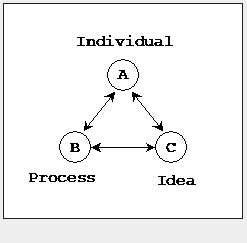
Bi-Directional Affect Relationships
Interconnections can be described as relationships as illustrated in the figure above. This is a three-element diagram for a basic system that shows connections through bi-directional arrows indicating relationships that exist between the elements. The relationship between these elements could be positive such as synergy or intuition; or negative, such as conflict and fear. Elements define the relationship between themselves and are sometimes referred to as variables where “the value of the outcome = a specified relationship between the controlled variables and the uncontrolled variables” (Ackoff, 1999, p. 138).
Classical systems theory integrates mathematics such as calculus to define or state principles that are reflective of general or open/closed innovation systems. Stated in a general way, specifically known innovation properties will apply to any “entity qua system even when its particular nature, parts, relations, etc., are unknown or not investigated” (Bertanlanffy, 1969, p. 20).
This can be modeled or communicated in ordinary language as a guiding idea even when it cannot be modeled mathematically and referred to as a “soft system” or “social system” (Checkland, 1999). Within the systems approach, innovation trends may be modeled as mechanistic or organic. The wholeness of the analysis may be reflected in linear, circular, or causality interactions that are also recognized as social dynamics.
Understanding innovation systems performance is clear in a theory that the system identity depends on how the innovation pieces or parts interact with each other and external characteristics such as individuals. These individuals create the interconnection through vision, “lastly a vision can die if people forget they're connection to one another” (Senge, 1990, 230).
A system is a whole whose essential characteristics and functions are not shared by any of the individual parts. For innovation, this refers to characteristics such as Focus, Adaption, and Methodology. The optimal performance of innovation systems can be classified as “the efficiency with which it does whatever it does [and] the effectiveness of what it does” (Ackoff, 1999, p. 10).
The interconnection between effectiveness and efficiency must be evaluated with a perception to recognize how to do the right thing and the value of that action. Described by Russell Ackoff (1999), “it is better to do the right thing wrong than the wrong thing right.” The clarity of this innovation systems theory is historically derived from the scientific movement, which was composed from the consequence of analytical thinking.
This thinking style was divided into analysis and synthesis. Analysis is synonymous with the Western philosophy of breaking separate pieces apart trying to understand how the system works at an elemental level. If the individual elements do not interact with each other, they form an aggregation, not a system. This immature understanding of the parts of the system is then “aggregated in an effort to explain the behavior or properties of the whole” (Ackoff, 1999, p. 12).
Synthesis is the understanding of the outer-containing system (sub-system or supersystem), which is disaggregated to identify or clarify the functions of the system being analyzed. These outer-system conditions are referred to as the innovation environment, which is defined at a functional level. These functions can determine if an innovation system is open or closed.
An open innovation system cannot be sufficient to function in all environments. This means that an outside influence can determine the predictable functionality of the innovation system. A closed innovation system can operate in a predictable pattern with variation inside it, but it has no outside influences, which modify its behavioral functionality.
Systems Thinking
Systems Thinking is a discipline for interpreting and seeing wholes. It is a thinking “framework for seeing interrelationships” rather than pieces. It is a thinking shift of mind from seeing individual parts to seeing the whole. From seeing people as helpless reactors to situations to active participants in shaping perceptions, change and reality. Innovation requires creating the vision and the transition to the future. The innovation perception shift allows an understanding of the difference between detail complexity and dynamic complexity.
Systems thinking provides the vision of seeing interrelationships rather than linear cause-effect chains and the awareness of the concept of feedback. The limitations of system thinkers are in the recognition of circles of reality rather than the fragmentation of straight-line thinking. Plato’s Republic presented this challenge of continual awareness as a challenge to man. “Therefore in an ideal state, as I conceived it, man would not be problem free, but would be capable of solving a continual flood of increasingly challenging problems” (Ackoff, 1999, p. 141).
To be successful takes understanding and recognition of both types of thinking. The integration of the understanding of detail complexity and dynamic complexity will allow a visual and cognitive clarity.
Water Logic
To understand system properties requires an understanding of the perceptions, flowscapes, and directional impacts of 'Rock Logic'. It is a tradition based on identity and the perception of “have” and “inclusion” which may have been Aristotle’s greatest contribution (de Bono, 1993, p. 9). Water Logic is based on “to” -– what does this flow to -– what does this lead to –- what does this add up to? (de Bono, 1993, p. 9).
It is unrealistic to believe that the behavior of relationships within a system needs to be “expressed in mathematical symbols which most people do not understand” (de Bono, 1993, p. 5). If we review the Bi-Directional Affect Relationships figure and add three more innovation components to it, we can systemically map the complexity of the Innovation Cube Theory. The cube has been symbolically unfolded and the “arrows between the blocks define the flowscapes, and the flowscapes describe perception” (de Bono, 1993, p. 5).
The arrows illustrate “multi-directional repeating loops” which allows a self-organizing system of stable loops (de Bono, 1993, p. 42). These loops allow entry and exit into the system at any location. De Bono’s Water Logic theorem for this states that “from any input a system with a finite number of stable states and a tiring factor will always reach a stable repeating pattern” which can be seen in the figure below (de Bono, 1993, p. 42).
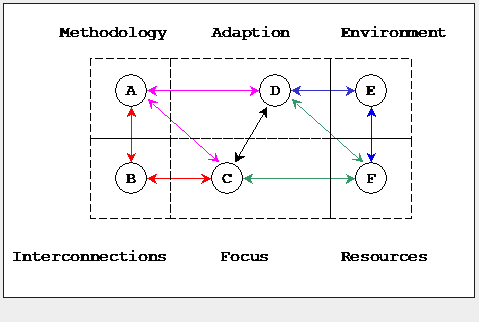
Multi-Directional Interconnected Relationship
The Innovation Cube conceptual model can be translated into a system of flowscapes that will allow users to lead themselves to “different ideas” depending on the path they choose (de Bono, 1993, p. 14). The “purpose of any conceptual model is to provide something useful. Otherwise models remain mere descriptions and one description is as good as another” (de Bono, 1993, p. 75). The Innovation Cube flowscape model is meant to describe the inner world perception of a system of innovation as opposed to the traditional recognition of separate characteristics and the random integration of individual pieces. Deming (1994) captures the spirit, necessity, and essence of this type of system by recognizing that “if the whole is optimized, the components will not be” (p. 58).
Paradox and Duality
Exploration into the cognitive balance uncovers the concept of paradoxical intention, which is very much like a metaphysical paradoxical equation. In logotherapy theory the mind and how we construct meaning are projected to the future. The realism of the situation is forced cognitively towards inventing an existence in the mind (Frankl, 1984, pp. 119-157).
This new dimension creates tension dynamics in a polar field allowing the opportunity for innovation in a “Bifurcation Area” (Morgan, 1998). It is proposed that the existence of 'Innovation Existentialism' which is a philosophy that emphasizes the uniqueness and isolation of the individual experience in a hostile or indifferent universe, it regards human existence as unexplainable, and stresses freedom of choice and responsibility for the consequences of one's acts. Freewill versus consequentialism.
Frankl (1984) describes the existential world or culture and the existence of a specifically human dimension called “Noögenic Neuroses” (p. 120). “Noös” comes from the Greek root meaning mind dimension. This neurosis is a cognitive tension between the current situation and another situation that exists in another time, typically the future, establishing an environment for personal cognitive paradox. As described, the symptom diminishes and finally atrophies, but we are warned that there exists a dangerous misconception that we are striving for equilibrium.
The human mind requires cognitive stability that is independent of this. Any questioning or challenging of the "basic assumptions" releases a defense mechanism that causes anxiety (Schein, 1992, p. 23). This means that cognitively as we construct meaning, it contains an inherent situational paradox; and along with that tension, comes the opportunity for innovation.
These paradoxes become the internal conflicts that are visible and experienced at one specific time in place and provide the underlying assumptions visible within the environment exhibited as conflict between each other if recognizable (Schein, 1992, p. 17). De Bono describes this as “a sort of paradox in the mind that is extremely good at recognizing things and yet poor at noticing things” (de Bono, 1993, p. 149). The point being made is that unless a specific effort is made to recognize the paradox, it is invisible and not noticeable.
Bifurcation
This paradox is typically not understood at a definitive level. It is authored here that the area of paradox conflict intersects or combines and is referred to as a “Bifurcation Area.” The sudden appearance of a problem is the uncomfortable trigger alerting us that a conflict exists and there is a lack of balance between the paradoxes.
When the two features co-exist in balance, they are not recognized as competing. They simply exist as “being there.” The resurgence of this conflict can be exhibited as trying to solve a problem that has been previously solved or repeatedly creating innovation that has been created previously (Morgan, 1998, p. 249). Further, during naive analysis of the situation, sometimes the initial response or objective is to make the competing theory go away, but the “paradox cannot be successfully resolved by eliminating one side” (Morgan, 1998, p. 251). What is unbalanced is the equilibrium between the two caused by a swing in the polarity and an area of potential innovation called bifurcation.
That Bifurcation Area and the interaction that happens in it are graphically represented referencing the organizational problems associated with the competing theories of Working Together versus Working Independently. The Bifurcation Area exists when two competing ideas collide or mix together. Suddenly, the competing theories cause organizational conflict and three possibilities can exist:
1. Rebalance of Paradoxes: a shift back from the intersection by one side or the other will allow them to regain equilibrium making the conflict appear to disappear.
2. Remain Competing: the organization ignores the conflict, and the imbalance continues causing organizational conflict and problems but only for those who immediately experience the paradox.
3. Innovation: a conscious or non-conscious event is initiated to create a new idea or combination of existing or new ideas forming a new paradox with historic lineage back to the two original competing paradoxes.
Innovation Cube Focus:
The third side of the ©Innovation Cube is 'focus', which is the concentration of clear understanding or cognitively perceiving the maximum distinctness or clarity of a problem or situation. Put another way it is the definition of a creative need or situation. In addition, it is the ability to “focus directly on pre-verbalized felt experiencing and to carry it forward concretely with attention, with words and with actions” (Gendlin, 1968, p. 237 cited in Slalien).
One of the problems encountered with creating innovation creation or problem solving, typically occurs long before a group or team tries to create ideas or alternatives because “to be focused in thinking is one of the hardest things to achieve” (de Bono, 1994, p. 114). To start creating a problem statement requires questioning the perceived problem at a level that is known as the “invitational stem” (Michalko, 1991, p. 29). Questioning a problem will help prevent immediately settling in on a single problem statement that may reflect only one perspective of the situation. 'What is required' is to “look for the appropriate level of abstraction, the best view point from which to gather ideas” (Michalko, 1991, p. 31). As proposed by Dillion (1982), there are three levels of problems that need to be explored with a focusing tool:
- Existent – Problems that are clearly posed, clearly articulated, and clearly understood.
- Emergent – Problems that are waiting to be discovered by viewing the environment where the problem exists.
- Potential – Problems that are understood by an individual construct with the elements present in the situation.
The process of formulating problems to be solved has been referred to as problem finding or recognition and exists at the level of understanding required “so that relevant knowledge can be recalled and utilized” (Cowan, 1986, cited in West 1990). Misunderstanding the recognition of the problem revolves around a lack of clarity of the true problem. This lack of understanding can include solving the wrong problem, or the existence of a compound problem nested together which cannot be deciphered from the original issue.
Clearly, “skilled focus with a little creative skill is probably better than poor focus with great creative skill” (de Bono, 1993, p. 93). An accurate focus sets the initial direction and path for the innovation or idea creation session that can lead the team in the direction of solutions based on psychological inertia. These tendencies to “group think” or use the same pattern, limits the ability to search for ideal solutions (Janis, 1973). The resulting psychological inertia can create a negative effect when formulating the problem to generate ideas. If the team prepares the Focus or Problem Statement incorrectly, it has a direct influence on the outcome of the results or alternatives and will lead to problems in defining ideas that have utility towards the initial requirements or objective.
Focus Statement
A Focus or Problem Statement is the formulated question presented to the group to produce alternatives. This process of choosing an entry point in an attention area is a practiced discipline around “thinking about the thinking” (de Bono, 1970, pp. 175-192). Inadequate focus will have characteristics and the negative impacts of:
1) Blockages: cognitive situations where something will impede the thinking and preventing it from moving forward.
2) Repetition of certain ideas: patterns or cycles that will not allow the participants to move into a new area of thought.
3) Emotional points: cognitive points that cause the participants to focus on negative emotions or memories which prevent thinking of alternatives.
4) Blank spots: a stopping point or void that is not initially seen but prevents the participants from moving forward.
5) Starting point: a lack of strategy causing the inability to view the entry point from which to get to the final objective.
6) Psychological inertia: the lack of clarity around the complexity of a problem.
In untrained thinking, certain ideas trigger an emotion, which can determine the way in which something is perceived. This perception and the following thinking creates a paradigm (Kuhn, 1974) which can produce a “path without any genuine exploration of the subject” (de Bono, 1994, p. 114). According to de Bono (1993), there are four types of focusing categories that allow for exploratory thinking.
- Simple Focus: deliberate attempt and willingness to think about things that do not demand thinking.
- Specific Focus: an individual or group-defined focus about thinking that is deliberately and seriously applied to create new ideas.
- General Area Focus: define the area for the focus but not the purpose.
- Purpose Type Focus: define the specific purpose or goal of the thinking.
A 'focus' can be accomplished through a variety of redefinition processes. Two of the strongest are the “Ladder of Abstraction” which is a heuristic-based application (Hayakawa, 1990) and/or the “Simplex” (Basadur, 1998) model for converging the 'focus' or 'problem statement'.
This process allows the ability to distinguish identifying characteristics that are critical to the original thought. It is a method of heuristic analysis and discovery providing bounded rationality around thinking. The original problem or focus statement is placed in the center of a piece of paper, and extensions from this original statement extend upward by asking “why” questions. There is an instinctual tendency to run out of responses to the why questions and say because. The “whole point of the exercise is to avoid feeling that anything is so obvious that it merits a because answer” (de Bono, 1970, p. 100).
A small child continues to ask “why” in the same process looking for all of the answers. The answers to these questions will redefine the focus statement and allow the visibility to see a different or multiple problem by repeatedly exploring “what’s stopping you” in the descending questions from the original problem statement. The premise of a question helps you look at challenges and problems from a different perspective, “sometimes a different perspective will stretch your eyes wide open” (Michalko, 1991, p. 28). The questioning format seen in the 'ladder of abstraction' creates that perspective.
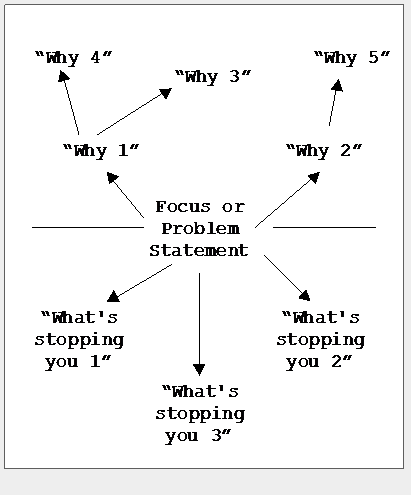
Ladder of Abstraction
This questioning methodology should be repeatedly applied until the process has reached the point where it has been “questioned to the void” (de Bono, 1993). The void is the point where it does not make sense to ask the question anymore. It has pulled away from any meaning or linkage to the original problem and even with interconnections has no value to solving. This allows the individual to move their “attention from the interpretation of well articulated forms to those which are as yet unformulated” (Stein, 1974, p. 78). Once this process has been accomplished, the accurate and relevant focus or problem statements are ready to be utilized in a valid idea-creating session.
It is subjective, but a heuristic process should allow the user or group to recognize what focus statements are not required for utilization and should fall out of the innovation/creativity session.
If it is phrased so that a 10-year-old child will understand it, the success will be much more successful. In highly complex problems, there are many unique self-defined words or acronyms that can have multiple or different meanings. It becomes critical to make sure that everyone fully understands the defined problem and recognize it at the same level. This process of redefinition of clarity provides a “reframing” (Bolman, 1997) which allows the participants to understand the information equally. It rebalances and educates the audience so everyone understands the direction to move towards.
Innovation Cube Environment:
The fourth side of the ©Innovation Cube is Environment. This feature of innovation is a reference to the circumstances or conditions that surround the innovation process and people. What needs to be established is a “support network of people you trust” to help create new insights in a “safe environment” (Miller, 1999, p. 88). This safe environment for innovation should mimic kindergarten, “a series of projects, interspaced with games, challenges and plenty of fun” (Kelley, Littmann, 2001, p. 73).
Centers of creativity and innovation tend to be at the apex of the “intersection of different cultures where beliefs, lifestyles and knowledge mingle and allow individuals to see new combinations of ideas with greater ease” (Leonard & Swap, 1999, p. 30). The movie Mary Poppin’s described the work of cleaning a child’s room with the phrase “in every job that must be done, there is an element of fun” (Kelley, Littmann, 2001, p. 73).
Environments that emulate this philosophy have transitioned into higher performance pockets that attract talented employees and engage customers. The “Pikes Place fish market in Seattle is a good example” of this environment where the fish are thrown to the customers as a gag and wrapped in newspaper to create shapes for comedic food transformation (Kelley, Littmann, 2001, p. 208).
By adding extra zeal and fun into the environment “you may have people lining up as if they were going whale watching” (Kelley, Littmann, 2001, p. 208). Many organizations establish norms for innovation that are centered on the ability to perform in what is referred to as the culture.
Culture
A strong culture can have a powerful impact and consequences for a group to “take rapid and coordinated action against a competitor or for a customer [while at the same time] leading intelligent people to walk in concert, off a cliff (Sutton, 2002, p. 65). Some companies create these cultures accidentally but others believe that “a strong culture leads to performance” (Sutton, 2002, p. 65). This can be translated into a tremendous need for “variance in ideas and actions [because] believing in and imitating old ways is problematic” for post-millennium companies (Sutton, 2002, p. 67).
Innovation requires a “living culture [that is] self propagating which finds new ways of staying fresh” to recreate itself (Morgan, 1999, p. 198). Almost all models for culture and change have a sequence that the individual follows, “Action -- Behavior -- Culture” (Morgan, 1999, p. 198). This repetition over time creates a predictable behavior and “in time shared behaviors become a culture” (Morgan, 1999, p. 198).
Cultures need to be updated to stay current with the expectations of the customer. In a culture of “mediocrity, complaining, blaming and making excuses replace accountability” and creates a mindset that filters through the organization producing the acceptance of poor behavior. (Imparato, Harari, 1994, p. 105). This behavior can be seen as an acceptance of “missed deadlines, quality deficiencies, aimless meetings and being late” (Imparato, Harari, 1994, p. 105). In excess this is a culture “where colleagues do not respect agreements among themselves” which makes it clear that they would never respect agreements and promises made to customers (Imparato, Harari, 1994, p. 257).
What must happen is a “culture shift” which runs through the entire organization including changes in expectations and support for personal responsibility to assure that the “bureaucracy that smothers customer complaints” does not exist (Imparato, Harari, 1994, p. 105). A philosophy that captures this spirit is called “looking one customer ahead” to anticipate what type of culture is needed asking the question of everyone, “How do you want to touch the future?” (Imparato, Harari, 1994, p. 276).
Communication
Innovation requires a special type of communication model, which can appeal to the sender and receiver of information. The “mindset of most Chinese engineers is that they won’t want anyone to see what they are doing until they are done” (Schrage, 2000, p. 92). Innovation requires a mindset of collaboration and iterative evaluation of ideas, concepts, and mental models. The philosophy that “better communication was the essential ingredient in collaboration was false; what was needed was a different kind of communication” (Schrage, 2000, p. XIV).
The key to this different type of communication is a “shared space” model, which allows collaboration as seen in the figure below (Schrage, 2000, p. XIV).
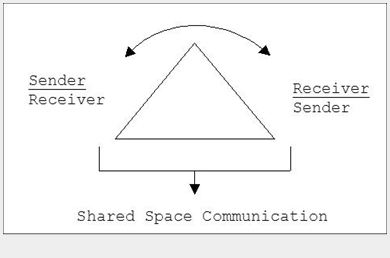
Collaborative Communication Model
The typical communication model is represented as “sender/receiver -- conversation -- receiver sender” which is a transactional communication process (Schrage, 2000, p. XV). This transactional process does not create an environment that is shared; it is directed from one person to another with very little opportunity for sharing or collaboration.
It must be seen that there is not “one best communication style.” What must be recognized is the McKinsey principle of “keep the information flowing” because information is power (Rasiel, Friga, 2002, p. 137). Information is one of the resources available that can increase its value as it is distributed and shared by others.
Communication is a critical elements of effective innovation, and all organizations develop a “communication culture that governs the type and frequency of internal communication” which can be e-mail, phone calls, and verbal conversations between its members to name a few (Rasiel, Friga, 2002, p. 137). The rule for innovation communication is to remember that:
- You have two ears and only one mouth.
- It’s not just what you say, it’s how you say it to others.
- Over communication is always better than under communication. (Adapted from Rasiel, Friga, 2002, p. 138)
Interactive communication in innovation is the “lifeblood for innovation” which requires four important skills:
- Listening
- Presenting
- Connecting with others for ideas
- Honest open communication
Of these four, only the presentation skill is taught (usually poorly) (Leonard & Swap, 1999, p. 29).
Managing Innovation
The premise of managing innovation is a challenge at best and a frustrating journey of schedule and product challenges that relate to never-ending people problems. The “professional manager finally reins in the mess, they can create order out of chaos, but they can also kill the entrepreneurial spirit” (Collins, 2001, p. 121). Senior Management must team with radical innovators to create an “innovation friendly culture” consisting of the right organizational structure (Leifer, 2000, p. 181). This double-edged sword challenges mangers to create rules, but many entrepreneurs have a different philosophy. For them to succeed they may need to “flaunt conventional rules” (Morgan, 1999, p. 196).
One of the hardest tasks for a manager is the changing of a cultural direction. To accomplish this requires “changing the basis reference points and changing the core vocabulary to describe the task ahead” (Morgan, 1999, p. 197). This requires shaping the organization in ways that make “radical innovation a more natural, accepted and valued activity” (Leifer, 2000, p. 164). One method to accomplish that is to create organizational challengers who are responsible for questioning “why” things are the way they are, this will allow a 'flying instability' in the “organization to provide flexibility and innovation” (Morgan, 1999, p. 196). This flexibility in innovation should be seen as management taking steps to eliminate or minimize unnecessary obstacles.
Once the flexible and innovative structure is in place, a special environment will start to flourish. This environment will contain “an investigative spirit [for innovators that will] encourage their work and provide recognition and rewards” (Leifer, 2000, p. 165). This sets the stage for organizations that understand the need to “incentivize and reward people for being innovative rather than playing it safe” (Morgan, 1999, p. 199).
The social and psychological environment are important, and managers must strive to create a culture that is “safe, desirable and even for the group members to express creativity” (Leonard & Swap, 1999, p. 165). This moves beyond traditional supervisory roles and requires “managing creativity which inspires passion and enables serendipity” while at the same time mixes cultural differences to aid the positive features of creativity (Leonard & Swap, 1999, p. 165). Passion is a unique feature of personality that cannot be manufactured. Organizations and managers must strive to “discover what ignites passion and the passion of those around you” to fuel entrepreneurial success and imagination (Collins, 2001, p. 109).
Stories
The history and stories told within the environment and culture have a direct impact on the ability of the people to perform today and in the future. One of the strongest innovation cultures documented exists at 3M where everyone talks about “D. Drew the inventor of Scotch tape” (Gundling, 2000, p. 73). The culture of previous success is translated into Appledorn’s citing of three vital factors in fostering innovation: culture, communication and style” (Gundling, 2000, p. 72). That history concludes that managing technical innovation successfully requires:
- Hero’s, Freedom, Excitement and anticipation, never giving up, understanding there is value in failure and fun.
- Mentoring, a clear vision, ambitious goals, planning, opening doors, interfacing with the customer and rewards.
- Personal involvement, being a servant, elimination of barriers, breaking the rules, trust and credibility, risk taking, being a champion, taking time, giving credit and empowerment. (Adapted from Gundling, 2000, p. 79).
IDEO, which is a creativity and innovation company in Northern California, tries to establish what it calls “organizational lobbies” (Leonard, Swap, 1999, p. 158). These are similar to the homes of the people who work there, “they tell a lot about the culture and values of the inhabitants” (Leonard & Swap, 1999, p. 158).
IDEO believes that “creativity groups are made not born” and that a group of “ordinary intelligent people in a creative environment are more likely to innovate than a group of creative people in a stifling environment” (Leonard, Swap, 1999, p. 164). Additionally, they believe this so strongly that they have written two books about the IDEO culture and environment to tell the story for others to understand.
MCI’s Liebhaber sees innovation as a key element in risk taking and visa versa. His comments are that they do not shoot people who make innovation mistakes, “we shoot people who do not take risks” (Leonard ,Swap, 1999, p. 165). Amgen, a biomedical company in Southern California, which has taken over some of Abbott Pharmaceuticals products has created a very “discipline organization” when it comes to innovation but not in a “linear way of thinking” (Collins, 2001, p. 123). They use financial discipline as a way to provide resources for really innovative projects. A bi-product of this culture is people who take “discipline action” which tries to:
- Build a culture around the idea of freedom and responsibility within a framework.
- Fill the culture with disciplined people who are willing to go to extreme lengths to fulfill their responsibly.
- Not confuse a culture of discipline with a tyrannical disciplinarian. (Adapted from Collins, 2001, pp. 123-124)
SAS was challenged with a traditional bureaucratic model for power and authority, which desperately needed to change for the company to continue to survive. J. Carlzon selected one person from the organization and instructed them that he was “putting them in absolute power of delivering this goal” (Morgan, 1999, p. 197). They were not allowed to have budget control over the goal but “ultimate power” which was responsible for turning the organizational pyramid upside down and providing accountability and responsibility at the lowest level where it could be effective (Morgan, 1999, p. 197).
H. Keller from Southwest Airlines describes his recruitment strategy as being “primarily a search for a sense of humor, for the right attitude” (Morgan, 1999, p. 199). All of these stories provide a small glimpse into what is required as a collective innovation and creativity-centered environment or culture. The impact of the stories personalizes the message into a form, which everyone can understand in relation to their own position in a company.
Innovation Cube Adaption:
The fifth side of the ©Innovation Cube is 'adaption', which is the process of making something suitable only to the point where it will fit for a new use. When translating this to individuals, it can be said that adaptors “like to work within a given paradigm or way of resolving or seeing problems” but innovators “like to develop a new paradigm or way of seeing and resolving problems” (Miller, 1948, p. 123). This definition is balanced in a “paradox of duality” which defines the degree of Adaption in innovation (Morgan, 1998, pp. 249-251).
Within the realm of duality is the need to understand the “systemic differences and similarities” of studies of innovation that discuss future creativity (Stein, 1974, p. 290). This process of introducing innovation to a general audience or members describes a five-step process for innovation adoption or acceptance:
- Awareness: exposure to the innovation with limited or incomplete information.
- Interest: interest in the innovation and may be perceived as favorably inclined to it.
- Evaluation: mentally tries out the innovation to determine if it will satisfy the need.
- Trial: small scale use to determine the innovation utility.
- Adoption: decision on acceptance or rejection of the innovation.(Adapted from Stein, 1974, pp. 290-291)
Innovation adaption can be measured and historically monitored on an S-curve that matrixes time on one axis and performance on the other axis. This measurement of innovation was seen by Salk (1981), who was responsible for helping prevent polio, as a way to “reflect a law of nature that governs growth in living systems . . . and reflects the transformational character of change in our time” (Imparto & Harari, 1994, p. 97).
Salk separated the S-curve into two segments. The first segment represents a situation where innovation is growing; the second segment is where innovation begins to decline. This evolution is a repeatable measurement of innovation development and adaption. Another critical measurement of innovation adaption is called diffusion and technology transfer.
Diffusion Theory
One of the forefathers of sociology and psychology was Gabriel Tarde, a French lawyer and judge around the turn of the 19th century. Tarde reviewed trends in society that were presented to him as legal cases in his court. He observed certain generalizations about the diffusion of innovations that he called the laws of imitation. The reason for his academic observations was “to learn why, given one hundred different innovations conceived at the same time –- innovation in the form of words, mythological ideas, in industrial processes, etc. -– ten will spread abroad while ninety will be forgotten” (Tarde, 1903/1969).
This sociological pioneer observed, similar to Salk, that the rate and adoption of a new concept or idea followed an S-shaped curve. Other anthropologists in England and Germany/Austria called themselves diffusionists and claimed “all innovation spread from one original source, which of course argued against the existence of parallel innovation,” but it is known that parallel innovation of new ideas is possible and frequently occurs (Rogers, 1999, p. 41).
Diffusion is defined as the process by which: innovation is, communicated through certain channels over, time among the members of a social system.
- Innovation is the object or practice that is conceptualized as new by an individual or the enterprise that will be adopting it. This perceived newness of the idea happens prior to any specific attitude or opinion expressed toward it.
- Communication is the process by which people create and disseminate information among each other in order to reach a bounded and mutual understanding of the data. Diffusion communication relates to the message content containing a new idea. Underlying the diffusion process is its essence, which is information exchange at its elemental form, frequently between two individuals who are “homophilous” (Lazarsfield & Merton, 1964). This exchange occurs because similar individuals belong to the same network, community, social group, or work and share similar beliefs, interests, and philosophical ideas creating high empathy.
- Time is known as the innovation-decision period that is the span of time required moving through the single, individual, group, or adopting units in the innovation-decision process. This process is the measurement between the initial exposure from the communication through the decision to accept, reject, implement, or confirm a decision about the proposed innovation.
- Social System is a set of interrelated members that are tasked with the responsibility to engage in joint problem solving towards a common goal. This social system can contain individuals, informal groups, and social organizations. All members agree to seek the solution to a common problem moving towards reaching a common goal or objective that binds the system together. “Almost by definition, innovations threaten the status quo, and for that reason often provoke fear and resistance,” which is seen in the limited acceptance of common goals (Kim & Mauborgne, 2001, p. 96).
These members establish behavioral patterns or norms that define the range of acceptable tolerance behavior and create a standard for the actions of the social system in a classical diffusion theory model. Norms can be a barrier to change and prevent acceptance of logical ideas or concepts and “can operate at the level of a nation, a religious community, an organization or a local system” (Rogers, 1999, p. 26).
This classical diffusion model was challenged and redefined by Schon (1967) as a “center periphery model” while arguing that diffusion theory lagged behind the reality of new and emerging diffusion systems. It failed to recognize “the complexity of relatively decentralized diffusion systems in which innovations originate from numerous sources and then evolve as they diffuse via horizontal networks” (Rogers, 1999, p. 364).
The innovation system can be separated into Centralized and Decentralized Diffusion Systems that operate differently in the idea transfer to adopters who are responsible for acting upon them. A Centralized Diffusion System is very controlled and hierarchical in the flow of communication of data.
Centralized Diffusion
The primary characteristics of the Centralized Diffusion System are that innovation is managed at a high level. In the R&D (Research and Development) function, innovation is transferred to the change agent, which can become a choke point preventing fast decimation of flow to innovation adoptors. This is then directed to the opinion leaders who are then responsible for diffusion of the innovation.
Change agents must have heterophily for diffusion to happen and the relationships that support this are critical. Perceived heterophily involves formulating a judgment and then reactively performing or not performing to a behavioral action. The communication flow in the Centralized Diffusion System is very hierarchical and prevents the opportunity for speedy implementation and the combining of relationships at the same level. In certain situations the “innovations become unintentional secrets, known only to the close associates of the people involved in these initiatives” (Senge, 1999, p. 460).
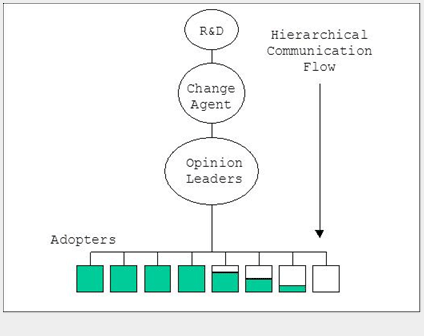
Centralized Diffusion System
These relationships provide a bounded understanding of the type of innovation required and prevent any hybridization or customizing of the innovation at the adopter level. “One size fits all” and if that size is not applicable, the diffusion of the innovation may not happen. One specific example is that of an Agricultural Extension Model, which has been proposed as the defining metaphor for “all technology transfer efforts” (Eveland cited in Rogers, p. 375).
This model contains a specific set of assumptions, principles, and structure for diffusing agricultural research in the United States. Early attempts to transmit research-based knowledge from colleges to farmers were unsuccessful. In 1914 university educators at Ames, Davis, and Ithaca colleges wrote bulletins intended to help diffuse and spread technical information to these farmers.
The professors wrote bulletins that “the farmers could not read or understand the technical content” (Rogers, 1999, p. 359). To offset this hierarchical flow, information campaigns of professors called the “Corn Seed Gospel Train” were organized to tour local communities and challenge local communities in favor of agricultural innovation.
The initial technical information was often received eagerly, but there was a lack of follow-up on information preventing the transition into agricultural improvement societies. These societies were repositories of local community members chartered to promote agricultural innovation.
De-Centralized Diffusion
A different approach to Centralized diffusion is accomplished through De-Centralized Diffusion. De-Centralized diffusion differs from Centralized Diffusion because the social structure of innovation adaptation is handled at a local level. This means that no hederophily is required for innovation acceptance. The communication flow is very vertical allowing for fast, clear communication and the ability to quickly implement and customize the needs. These needs can make the difference between an innovation being accepted immediately or requiring the reclarification at a higher level and then communication back down to the local adopters.
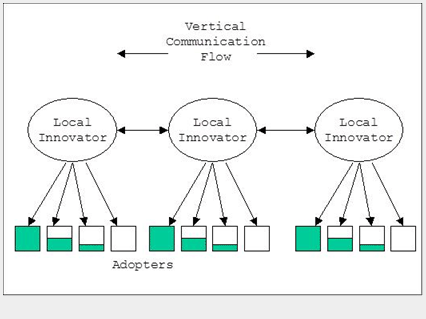
De-Centralized Diffusion System
The notion that we are single-handedly able to uncover new truths about innovation while the remaining unclear about the human struggle is wrong. The de-centralized diffusion methodology concentrates on minimizing socio-demographic characteristics moving away from social choices that depend on similarity.
In addition, de-centralization may provide the opportunity to view time differently. The monochromatic features of linear innovation may be more accurately modeled as polychromatic in the de-centralized model. Decentralized diffusion may allow the ability of local adaptors to think about multiple things simultaneously with a higher tolerance for ambiguity. There are tremendous advantages with the de-centralized diffusion process versus Centralized which are typically centered on the flow and communication of information.
Technology Transfer
Another feature of Diffusion Theory is Technology Transfer. Many innovation examples exist where diffusion does not occur even when the new innovation has technical merit. For example, the QWERTY keyboard, a manual typewriter keyboard, was designed at the turn of the 19th century to purposely slow down the typist, who continues to lock striking keys together, allowing the user time to shift the carriage up and down to access capitalized letters.
A redesign of the keyboard was accomplished that led to the Dvorak keyboard. This design optimized the keys to utilize hand functions for striking the keys. Further, the research and innovation explored how to optimize the hand/finger positions and the speed of the keyboard.
This keyboard failed to become accepted regardless of the obvious superiority over the QWERTY keyboard because of “vested interests” (Rogers, 1995, pp. 8-10). The psychological inertia present to remain with the original keyboard design is created by all of the people who know the old method. This includes all of the typing/keyboard instructors who teach its use and the fact that 99% of the hardware in existence uses a QWERTY keyboard. The technology cannot transfer from member to another member due to the culture of the organization and the influence of the opinion leaders aka local adaptors. The key to technology transfer is two-way communication and a mutual understanding of meaning.

Technology Transfer Model
Five characteristics are prevalent in the process of technology transfer.
- Relative advantage: the degree to which the innovation appears to be superior compared to existing products.
- Compatibility: the degree to which the innovation matches the values and experiences of the social members.
- Complexibility: the degree to which the innovation is difficult to understand or be used.
- Trialability: the degree to which the innovation may be experimented on a limited basis.
- Observability: the degree to which the innovation is visible to others.
Innovation Cube Resources:
The sixth and last side of the ©Innovation Cube is 'resources'. This feature of innovation is a reference to the total means available for concept development, such as financial support and commitment, teams, people and idea champions/leaders, and kinesthetic objects. Resources and resource allocation should support the management vision of three types of project strategies:- To be competitive.
- To lead innovation today.
- To lead innovation tomorrow. (Adapted from Miller, 1999, p. 243)
To accomplish this means recognizing that resources for next generation innovation are “not simply expenses on an income statement or projections in next year’s budget. Nor are they the facilities -- the laboratories, the office space, and the equipment -- that people use in the process of innovation” (Jonash & Sommerlatte, 1999, p. 56). Your resources actually include the financial support for innovation and people, equipment, technology, information, and most importantly “relationships” with suppliers and competitors who may simultaneously be partners and competitors (Christensen, 1997, p. 162).
The recognizable relationship between resources and innovation is “clearly more complex than many writers have allowed for” (West & Farr, 1990, pp. 34-35). Resources are the visible factors that allow an innovative organization to perform or fail and typically can be “hired and fired, bought and sold, depreciated or enhanced” (Christensen, 1997, p. 162).
There is a second tier of resources, which are not typically recognized as impacts to innovation. These innovation resources transcend the normal “boundaries of organizations much more readily than can processes and value” but are responsible for the capabilities of the organization, and these are the people resources (Christensen, 1997, p. 162).
People Resources
In the beginning of an organization much of the performance is measurable back to the people who initially performed together in the genesis of the organizational structure. This start-up team of initiators is affected by the “addition or departure of a few key people that can profoundly influence its success” and ability to continue performing at a high-innovative level (Christensen & Overdorf, 2001, p. 111).
This is clearly recognized in the situation where a new company has dedicated people resources, who are responsible for creating change. What is required is a transition team of resources for “bridging the gap” (Leifer, 2000, p. 190).
The transition team should include experts in the R&D team and the production development team to assist the people in moving forward with high expectations for success. A big danger to a “Radical Innovation” project is in identifying available people resources and figuring out how to get them; this is management’s responsibility (Leifer, 2000, p. 66).
Problems are always encountered when the management mentality exists to throw “any” non-dedicated or “slack” people resources into the innovation environment (Leifer, 2000, p. 66). These temporary resources can act as a cushion to relieve the temporary lack of personnel, and most traditional research has focused on the availability of slack people resources to the non-innovation organization (Rogers, 1993).
Financial Support
Traditional budgets for organizations never seem to include financial resources for innovation. This causes many “Radical Innovation” projects to “operate with minimal financial resources” (Leifer, 2000, p. 65). Examples of this are the “Dupont Biomax case” where it was seen that the radical innovation lifecycle was extremely successful with minimal financial resources (Leifer, 2000, p. 65).
This success story is one of the minority, not the majority. Many innovation projects must start with “boot-strapping -- using slack resources available to team members or provided by their formal and informal sponsors” (Leifer, 2000, pp. 66-65). Many times a “demand for short-term returns” is a barrier to efficient innovation potential, but there are highly successful firms this can be contrasted against (Leifer, 2000, p. 65).
One key issue with innovation is determining the ROI (Return On Investment) contrasted against the outlay of resources. McKiney & Company believe they have the “processes and values [in place to the point] that it almost doesn’t matter which people get assigned to which project team” (Christensen & Overdorf, 2001, p. 111). This maturity level of core capabilities is rooted in the company’s processes and values, which are seen as a success indicator minimizing the need for unique people resources.
Processes can only take you to a certain position, but some companies are “turning to joint ventures” as a way to evenly distribute financial risk and jointly bring together multiple resources that can benefit innovation for everyone involved (Ford & Gioia, 1995, p. 37). Small amounts of funding set aside that can be used to defer sunk costs can be extremely beneficial to innovation groups.
There may be a “negative relationship between resources and innovation, when the resources are in the form of sunk costs” (West & Farr, 1990, p. 34). While Teger (1980) argues that “individuals and group level work” follows a pattern of escalation where there may be too much invested in the innovation of an idea to quit (West & Farr, 1990, p. 34). This description of behavior patterns follows the thought that the more an organization has purposefully invested in an existing pattern of behavior, the less likely they will be to deviate from that original path.
Social Factors Influence
Resources are seen as the “most visible of the factors that can contribute to what an organization can and cannot do” within their sphere of influence (Christensen, 1997, p. 162). These resource factors can be “transferred across the boundaries of organizations much more readily than can processes and value” due to the lack of re-learning or change required (Christensen, 1997, p. 162). “Access to abundant and high quality resources enhance an organization’s chance of coping with change” while at the same time management structures that ignore change set themselves up for repeated failure (Christensen, 1997, p. 162).
The reward structure and process associated with innovation is one of the factors that can create cynical employees. An “inequitable reward system” is a breeding ground for skepticism and lack of trust. This ultimately creates behaviors that lead to:
- Employees who are skeptical about what they are told.
- Employees who question the competence of their managers.
- Legitimate initiatives, which are looked upon warily.(Adapted from Ford & Gioia, 1995, p. 37).
Positive strategies for innovation which include resources are considered excellent predictors for success, but some studies have provided “no evidence that more resources or better facilities lead necessarily to better scientific performance” in a technical environment (West & Farr, 1990, p. 114).
What may happen in these challenging innovation environments is a financial cost to benefit ratio which exceeds the payback for any level of innovation, even if it is a small adaption to the existing design. As “de Hemptinne & Andrews point out, the ration of benefit to cost for scientific innovations is too large” leading to failures in predicting conventional cost benefits associated with the social aspects of innovation intuition and serendipity (West & Farr, 1990, p. 114).
Social factors that are known are the ones that can destroy innovation and creativity. These factors are:
- Expected critical evaluation of the innovation output.
- Surveillance while working.
- Contracts for reward compensation.
- Constrained choices. (Adapted from Ford & Gioia, 1995, p. 78).
These in conjunction with “situational influences and differences in individuals” are seldom considered into the performance characteristics for creating Radical Innovation (Ford & Gioia, 1995, p. 37).
For more information on cost and event booking, email RPLC
